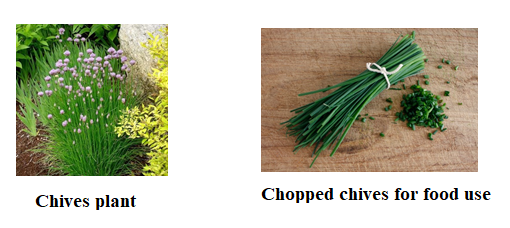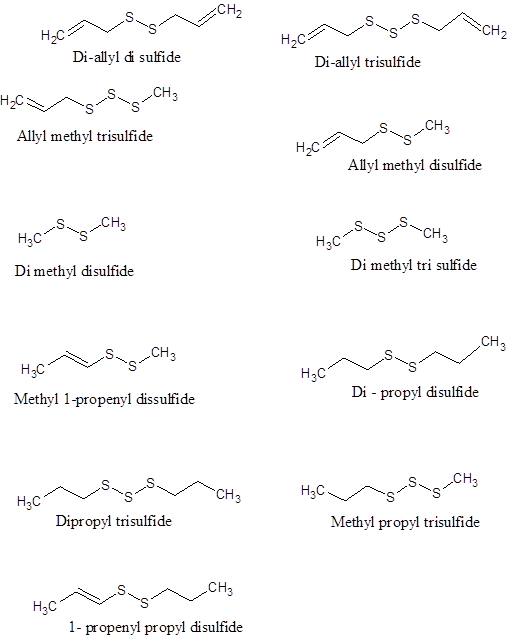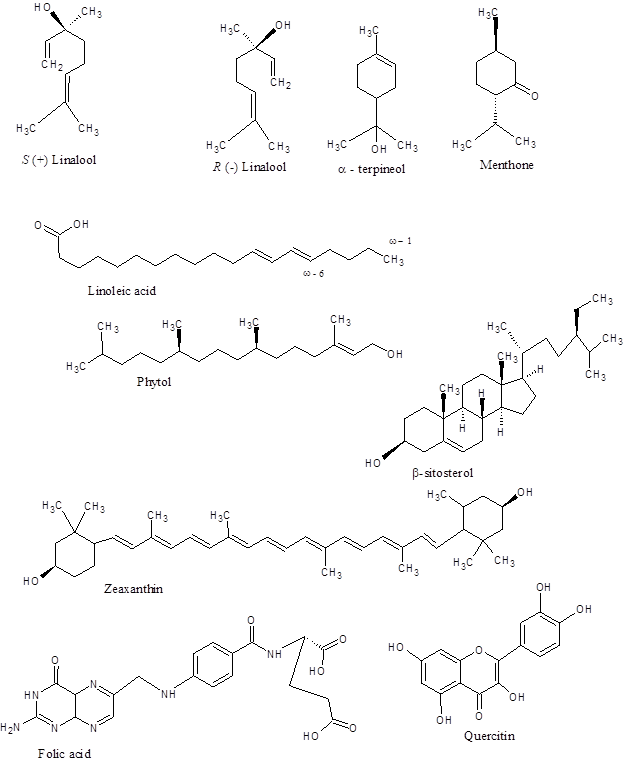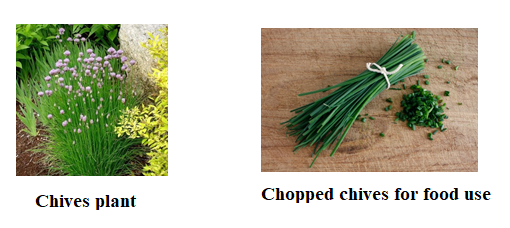Chives / Allium schoenoprasum

General features: It is a common herb normally available in any grocery store, often used for culinary tasks. Besides gardening outside premises, people often grow it inside the home. It is a perennial plant that can be easily grown from the stem. The known botanical name is Allium schoenoprasum belonging to the amaryllis family which has strong insect repelling property eg, Japanese beetles. Its juice can be sprayed for similar reasons to prevent fungal infections, scab and mildew. The name ‘Chives’ originates from the Latin word Cepa. But the English name is stemmed from the French word ‘Cive’ meaning differently like, Onion, in Latin. The herb is a member of garlic, scallion, and onion or shallot family which finds major use for the culinary causes. The plant grows 15 – 20 inches tall having conical shaped bulbs ~ ¾ – 1⅓ inches long and ⅟2 inches broad. It grows in clusters and the stems are hollow tubular shape ~ 20 inches in length and ⅟2 inch in diameter bearing star shaped flowers of light purple color. The seeds are grown in small capsules which become matured in summer. It is a native of Europe, North Africa, Eurasia and North America. The herb blossoms in drained soil with pH of ~ 7.0 under full sun light. The seeds germinate at ~ 700 F at moist condition. After about four weeks the young shoots start to appear which are then planted. In cold climate, the bulbs underneath the soil retain even after the death of plants. They start to grow up again with the warming of climate. Chives are used for varieties of food preparations, but mostly for fixing traditional European dishes. For daily uses, the fresh stems are chopped and added to the sandwiches, baked fish, soups, yogurt or cream cheese. It is considered to be a fine herb or delicacy in French cuisine. The frozen or dried form are also often used which show no sign of detoriation of quality.
History of Chives use: The herb is known for nearly five millennia. It was also once mentioned by the famous Roman poet Marcus Valerius Martialis who is considered to be the creator of modern epigram inscribing a satirical canto “He who bears chives on his breath, is safe from being kissed to death”. The Romans used to use it to relieve the pain of sunburn or throat sore. The Roman doctors advised patients for using Chives to lower the blood pressure and also for diuresis. The nomadic ethnic people, Romani / Gypsy often used Chives during fortune telling. Some also believed that bunches of Chives if hanged over the house would remove the evil spirit. Around nineteenth century Holland, farmers occasionally fed the cows to produce milk of different taste.
Medicinal properties: The medicinal facts of this herb is identical to garlic, but somewhat less in quantitative aspects. Since it has been traditionally used as vegetable therefore the medicinal values are largely ignored. In general, it has diuretic, antiseptic and stimulatory effect on nerves. The herb is enriched with Calcium, Iron, Potassium, Vitamin C, Vitamin A and large number of allyl sulfides expressing strong antimicrobial and antioxidant potential. Approximately 30 sulfur containing materials (~ 17 %) are identified from the steam volatile Chives’ oil. The strong unique smell of Chive is due to the sulfur derivatives.
Chemical components: The herb has large reservoir of vitamins and minerals (expressed in 100 g of dry material) eg, Vitamin – A (218 µg), β- carotene which is a precursor of vitamin –A is produced in large quantity (2650µg), Vitamin – C (60 mg), Vitamin – K (212 µg), Niacin (Vitamin – B3 – 650 µg, Vitamin – B5 (324 µg), Vitamin – B6 (350 µg) etc. Considering the minerals it also possesses them in appreciable quantities eg, Ca (92 mg), Fe (2.0 mg), Mg (42 mg), K (300 mg), Mn (0.4 mg) and Zn (0.6 mg). The essential oil extracted from various sources of chives has ~ 40 identifiable compounds of ~ 87 % of the total oil content. It has dimethyl disulfide (~ 20 %), allyl methyl disulfide (~ 15 %), di methyl trisulfide (~14 %), allyl methyl trisulfide (~7%), methyl 1- propenyl disulfide (~ 6 %) and di allyl disulfide (~ 5 %). Below is the list of several major sulfur and non-sulfur components of Chives.
Major sulfur and non-sulfur containing derivatives in Chives
| Categories | Compounds |
|
Sulfide derivatives |
Dimethyl disulfide, Di allyl sulfide,
Bis-1- propenyl sulfide, Allyl methyl sulfide, Methyl propyl sulfide, Methyl 1- propenyl sulfide, Di methyl tri sulfide, Di allyl sulfide, Di propyl sulfide, Allyl methyl trisulfide, Di methyl tetra sulfide, Methyl – 1(methyl propyl) di sulfide, Benzyl thiocyanate.
|
|
Non sulfide compounds |
Linalool, Menthone, α – Terpineol,
Methyl salicylate, 2 – Undecanone, Palmitic acid, Methyl linoleate, Ethyl linoleate, Phytol and Sitosterol, Quercitin, Folic acid, Lutein and Zeaxanthin. |

Pharmacological actions: Majority of the allyl sulfides have enormous medicinal role like, antibacterial, antimicrobial, anti-inflammatory and occasionally effective against various cancers. Among them, di-allyl disulfide which is formed initially from the Allicin and vice versa, is the important one. The later oxidation of di-allyl disulfide produces Allicin back again inside the plant.

The unpleasant smell of di-allyl sulfide or any of its derivatives is perceived due to the activation of Transient receptor potential cation channel – A1 (TRPA -1) in the olfactory neurons. This ion channel is located on the plasma membrane surface of human and animal neuronal cells. Interestingly, it often exists also on the fungi which makes those compounds acting as fungicide. Among the animals, TRPA-1 is ordinarily identified as environment sensor for sensing any irritants like, pain, itch, cold or foul smell. The di- or tri- sulfide moiety linking two allyl groups (H2C=CH−CH2-) within the molecule act efficiently as intracellular detoxifying agents. It boosts the production of Glutathione S – transferase that enables to bind the toxins of electrophilic nature. In that way, it particularly detoxify the liver and kidney cells and offers protection also to the nerve cells from the adverse influence of various oxidative stress. Besides acting as fungicide, it works as antimicrobial, insecticidal and larvacidal as well. Interestingly, it even protects stomach from ulcers by inhibiting the bacteria, Helicobacter pylori. The allyl di and tri sulfides also provide protection from the colorectal cancer.

Besides those, the monoterpenes like Linalool, Menthone, Terpineol and others also produce significant pharmacological effects. Linalool being an odorant having two enantiomers (R –) and (S +) act as good insecticide while repelling flies, mosquitos, fleas and cockroaches. Additionally, it can lower the anxiety level, blood pressure and heart rate possibly by acting as an antagonist toward the NMDA receptors. The compound Terpineol often used for the aromatherapy has blocking effect on action potential in nerves. At low doses it has sedative effect. Methyl salicylate is a potential inhibitor of Prostaglandin production thus behaves as analgesic and anti-inflammatory also. Linoleate is hydrolyzed to linoleic acid providing protection to hair loss, skin scaling and poor wound healing. The monoterpene, Menthone has strong pesticide role but inside the intestine it exerts anti-parasite effect. β – Sitosterol is a phytosterols originated from vegetable sources that has preventive role in benign prostate hyperplasia.
Medicinal benefits: Following are the benefits of Chives.
Digestive benefit – A large number of phyto-components in Chives produce impressive antibacterial role within gastrointestinal system especially acting against those belonging to the Salmonella family.
Cardiovascular benefit – The use of Chives is seen to lower bad cholesterol. Allicin particularly lowers the blood pressure and along with high level of K+ it imposes vasodilatory effect. Additionally, the flavonoid, Quercitin, a powerful free radical scavenger has potent cardiovascular effect preventing atherosclerosis. The presence of Folic acid also reduces the chances of stroke.
Immune booster – The herb promotes white cell production thus considered to be an immune booster. In addition, it induces collagen synthesis, helping producing cells, tissues, muscles and blood vessels.
Benefit on bone health – Large dose of vitamin – K present in Chives would help preserve the normal bone density since it is an important parameter for the maintenance of bone integrity. Besides, vitamin – K induces production of Osteocalcin, a very important hormone that also requires Vitamin – K for bone mineralization. The aging process often lowers bone integrity causing osteoporosis and stirring up the condition of inflammatory arthritis. In that regard Chives can be helpful for its prevention.
Benefits for vision – Lutein and Zeaxanthin in the herb lower the oxidation stress within ocular system thus preventing the formation of cataract in the eye.
Prevention of birth defects – Adequate amount of folic acid consumption is very essential for the pregnant mothers in order to prevent any neural tube defects in babies. Chive has appreciable amount of Folic acid content.
Detoxification – The components of Chives impose diuretic properties along with free radical scavenging and antibacterial actions and many others. Therefore stimulating the urination would help the physiologic environment to remove any toxins generated within the system allowing maintain healthy life.
